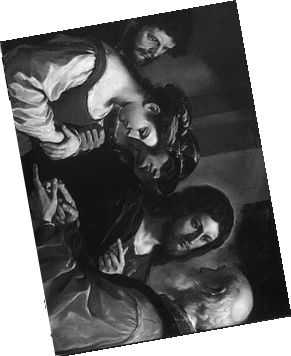双线性插值(Bilinear interpolation)的图像旋转在mobile上面的C++实现
在图像拉伸了以后, 很自然地我们想把图像的旋转也做进来。我们找来了图像旋转的公式:
X' = X cosθ - Y sinθ;
Y' = X sinθ + Y cosθ;
这个图像公式大家在高中数学课都是会算滴。 然后我们要扩展一下因为我们不是在原点做旋转,我们要围绕原来的图片中心做旋转, 那么我们假定原来的图像中心是 oldCenterX, oldCenterY.旋转完成以后, 我们要对图像位置坐调整,调整到新的坐标中心, 那么我们需要有个新的newCenterX, newCenterY;新的坐标就是新的图片的中心。那么我们的公式就可以转化成了:
X' = (X-oldCenterX) cosθ - (Y-oldCenterY) sinθ + newCenterX;
Y' = (X-oldCenterX) sinθ + (Y-oldCenterY) cosθ + newCenterY;
当然啦, 关键我们的问题不是旋转后的位置,而是旋转以后位置对于到原来的位置关系,也就是说我们更需要的是一个X,Y关于X'和Y'的表达式。很简单的,我们把问题变成了2元一次方程!
X = Y'sinθ + X'cosθ + oldCenterY - newCenterX cosθ - newCenterY sinθ;
Y = Y'cosθ - X'sinθ + oldCenterY - newCenterY cosθ + newCenterX sinθ;
这样要写个合适的代码就变得简单了。 但是另一个显著的问题就是没有三角函数怎么办呢? 就像我们插值的时候用大数一样, 我们用左移13位的大数来描述一下先,就像下面这样的:
//test interface for math const int K_CosineTable[24] = { 8192, 8172, 8112, 8012, 7874, 7697, 7483, 7233, 6947, 6627, 6275, 5892, 5481, 5043, 4580, 4096, 3591, 3068, 2531, 1981, 1422, 856, 285, -285 }; int ShiftCos(int y) { if (y<0) y*=-1; y %= 360; if ( y > 270 ) { return ShiftCos((360 - y)); } else if ( y > 180 ) { return - ShiftCos((y - 180)); } else if ( y > 90 ) { return - ShiftCos((180 - y)); } int index = (y >> 2); int offset = (y % 4); // on the borderline of overflowing if use JInt16 int cosVal = (4 - offset) * K_CosineTable[index] + offset * K_CosineTable[index + 1]; return cosVal >> 2; } int ShiftSin(int y) { return ShiftCos(y + 270); }
有了这个三角函数的辅助:我们的最后的代码就是这个样子:
/** ** method to remove sharp the raw image with unsharp mask * @param src input grayscale binary array * @param srcWidth width of the input grayscale image * @param srcHeight height of the input grayscale image * @param [output] dst output gray-scale image. * @param [output] dstWidth width of the output grayscale image * @param [output] dstHeight height of the output grayscale image * @param angle, rotate angle. */ void rotateImage (const unsigned char* src, int srcWidth, int srcHeight, unsigned char*& dst, int& dstWidth, int& dstHeight, int angle) { // first calculate the new width and height; const int SHIFT = 13; dstWidth = ( abs (srcWidth*ShiftCos(angle)) + abs (srcHeight*ShiftSin(angle))) >> SHIFT; dstHeight = ( abs (srcWidth*ShiftSin(angle)) + abs (srcHeight*ShiftCos(angle))) >> SHIFT; dst = new unsigned char [dstWidth*dstHeight]; int xcenter = srcWidth >> 1; int ycenter = srcHeight >> 1; int xnew = dstWidth >> 1; int ynew = dstHeight >> 1; const int xFix = ( xcenter <<8 ) - ((ynew * ShiftSin (angle)) >> 5 ) - ((xnew * ShiftCos (angle)) >> 5) ; const int yFix = ( ycenter <<8 ) + ((xnew * ShiftSin (angle)) >> 5 ) - ((ynew * ShiftCos (angle)) >> 5) ; int ox; int oy; int x; int y; int kx; int ky; int color [2][2]; for (int j=0;j
这里说明一下的是接口的定义,这里的和目标灰度图相关的参数都是引用类型的。表示都是输出的参数,因为图像旋转以后的大小会发生变化,函数外不是很方便事先分配好内存,所以这里采用了就地分配的模式。内存分配在函数内部完成。虽然没有用ticks去最后测速,但是想来没有浮点数的计算,这里的效率还是比较高的,当然这里一些细节的记录上还有可以再优化一下的,比如说这个常数5!!!Majic Number呵呵, 其实就是原来的那些数字都希望是左移8的, 所以三角函数中出来的数字需要左移5位!!除此以外就完全是公式的套用了 呵呵。
最后来点各个角度的效果图看看:
20度
40度
60度
80度
100度
120度





